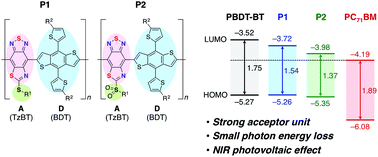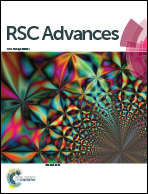Donor–acceptor polymers containing thiazole-fused benzothiadiazole acceptor units for organic solar cells†
Abstract
Two p-type semiconducting donor–acceptor polymers were designed and synthesized for use in organic solar cells. The polymers combine a benzodithiophene (BDT) donor and a thiazole-fused benzothiadiazole (TzBT) acceptor. Two TzBT acceptor units are compared, one with an alkylthio group (P1) and the other with a more strongly electron-withdrawing alkylsulfonyl group (P2) at the fused thiazole ring. The strongly electron-accepting nature of the TzBT unit lowers the lowest unoccupied molecular orbital (LUMO) energy of P1 and P2 relative to that of the BT analog (PBDT-BT), without altering the energy of the highest occupied molecular orbital (HOMO). Despite the smaller optical band gaps, bulk heterojunction organic solar cells fabricated using these polymers in a PC71BM blend showed high open-circuit voltages. The power conversion efficiency (PCE) of the P1-based device reached 6.13%. Though efficiency of the P2-based device was lower, photoelectric conversion extended into the near-IR region up to 950 nm.



 Please wait while we load your content...
Please wait while we load your content...